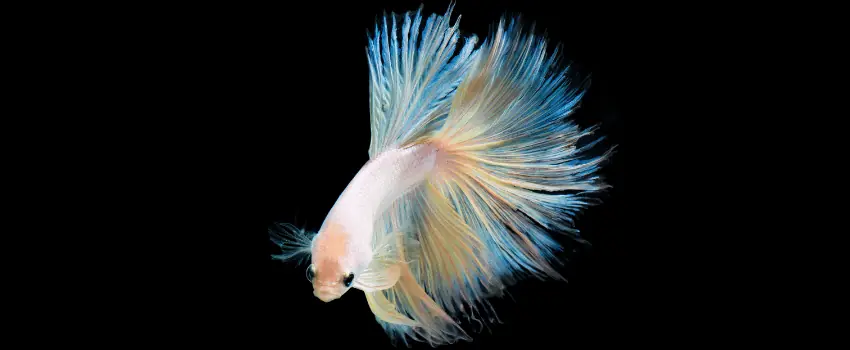Most betta fish species have a flashy appearance with bright colors.
But did you know there are white betta fish?
Pearl, or White Opal betta fish, is not as popular as the more colorful betta fish varieties.
Still, these white bettas have a stunning appearance rivaling their more vivid counterparts.
So, what sets the pearl betta fish apart from other colors of bettas?
Table of Contents
What Is a Pearl Betta Fish?

Pearl bettas have white bodies and fins with an iridescent sheen.
Some pearl bettas have a pinkish hue on their body or pastel colors on their fins. These colors look like opals, so pearl bettas are sometimes called White Opal bettas.
White Opal betta fish with the marbling gene may have black or blue fin edges. The marbling gene causes the black or blue colors to spread as the betta ages.
Pearl bettas with the dragonscale gene usually stay white for their entire lives.
Dragonscale bettas have thick, white scales on their body. If there is no pigment underneath these scales, the betta appears white.
White bettas are sometimes confused for albino or cellophane bettas. But, there are a few differences between these betta fish types.
Albino bettas have a complete lack of pigment, and their eyes are pink or red. There is a lot of debate about whether true albino bettas exist.
Cellophane bettas appear white, but their bodies and fins are actually translucent. Most cellophane bettas have a pinkish hue because their organs are visible through their skin.
Pearl bettas can have any fin or tail type. But the most common fin types in pearl bettas are the half-moon and crowntail varieties.
Are Pearl Bettas Rare?
Pearl bettas are less common than other varieties of betta fish. But, they are not considered rare.
As pearl bettas gain popularity, many fish hobbyists report finding them at their local pet stores.
Remember, many White Opal bettas sold in pet stores have marble genes. This means your betta may not stay solid white during its lifetime.
Dragonscale pearl bettas usually stay white as long as no marble genes are present. Bettas with the dragonscale gene are rare and usually sold by specialty breeders.
Average Cost of Pearl Betta Fish
Pearl bettas cost anywhere from $20 to over $50, depending on their fin types.
Crowntail and halfmoon plakat pearl bettas sell for more than other fin and tail varieties.
Dragonscale pearl bettas are the most expensive due to their rarity.
Breeding History of Pearl Bettas
The origins of pearl bettas are a bit of a mystery.
Pearl bettas came about through selective breeding.
Several genes in domestic bettas create the white color and pearlescent sheen.
Wild bettas have different color layers than captive-bred bettas. This means you won’t find white betta fish in the wild.
If you separate the scale layers of a betta, you see which layers combine for the white color.
Dragonscale and opaque genes make up the top layer of a betta’s scales. This layer is the thickest and can mask the layers underneath.
Dr. Gene Lucas created the first bettas with opaque traits.
The opaque gene has partial dominance. This means it has a higher chance of overriding other genes.
There are three types of opaque genes:
- Steel blue
- Green
- Royal blue
Bettas with opaque white coloring have the steel blue version of the gene. Green and Royal blue opaque genes do not produce pure white bettas.
The next layer contains iridescent genes. These genes give pearl bettas their shiny appearance.
Black, red, and yellow comprise the next three layers in domestic bettas. In wild bettas, the layer order consists of red, black, and yellow.
Pearl bettas usually contain the following genetics:
- C-The Cambodian gene: responsible for a light body color
- bl-Steel blue: gives a silvery appearance
- Si-Spreading iridocyte: iridescence on the body and fins
- Nr-Non-red: a lack of red pigment
- Op-Opaque pigment: gives a powdery white appearance
Some pearl bettas get their appearance from marble genes combined with steel blue and iridescent genes.
Do Pearl Betta Fish Change Color?
Many pearl bettas change color during their lifetime.
This is usually due to the presence of marble genes.
These color changes range from subtle colors on the fins to a complete body color transformation.
Buying a white pearl betta and ending up with a solid blue betta months later is not uncommon.
Many pearl bettas take on a pinkish body color as they get older.
There is usually no guarantee these color changes won’t happen in your pearl betta. But, there are some clues a color change is more likely.
If your pearl betta has color on the fin edges or specks of color on its body, these are signs of an imminent color change.
Color changes in white bettas may also occur due to poor water conditions.
Increased levels of ammonia or nitrites can cause red streaks on your betta.
Performing weekly partial water changes helps remove these toxins from your aquarium.
Ideal ammonia and nitrite levels for bettas are 0 ppm (parts per million).
These tropical fish also need warm water temperatures ranging from 78-80° degrees Fahrenheit (25.5-27° C).
Can Colorful Betta Fish Turn White?

Colorful betta fish can turn white or pale for a variety of reasons.
Your betta’s entire body may turn white or small patches of white can appear.
In most cases, bettas regain their original color once you solve the underlying issue.
Stress
Stress is a major cause of color fading in betta fish.
The stress may come from several sources, including:
- Poor environment
- Unsuitable tank mates
- Inadequate nutrition
- Undersized aquarium
Along with fading colors, your betta may have a loss of appetite or become less active.
Create a calm environment for your betta and remove aggressive tank mates.
Illness
Several common fish diseases cause color fading or white patches on bettas.
These diseases include:
- Columnaris
- Fin Rot
- Ich
- Fungal infections
Fuzzy white patches or a complete loss of color are common in these diseases.
Prompt treatment with the proper medications helps your betta make a full recovery.
Poor Water Conditions
Fish waste and leftover uneaten food increase ammonia levels in your aquarium.
Any level of ammonia or nitrites can make your betta sick and cause color loss.
Maintaining stable water parameters and performing weekly partial water changes improve water quality.
Using a low-flow filter for betta fish helps remove harmful bacteria and prevents stagnant waters.
Poor Diet
Bettas may lose their color if they do not receive proper nutrition.
Poor quality fish food does not have the protein these carnivorous fish need.
Keep your betta fish healthy with a nutritious diet of high-quality fish food and live or frozen foods.
Some excellent live food choices include brine shrimp and blood worms.
Old Age
Many bettas experience fading colors as they age.
The average lifespan of a betta is between 2-5 years.
If your betta acts healthy but has white or pale colors, it is likely due to old age.
Do Pearl Bettas Have Health Issues?
Pearl bettas have a higher risk of developing eye issues and diseases like popeye.
If your pearl betta has marble genes, it has a higher risk of developing tumors.
This is because the marble genes mutate more often than other genes.
These tumors are not always cancerous and may not affect your betta’s health.
Tumor development in bettas is rare, even with the presence of marble genetics.


